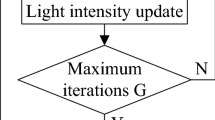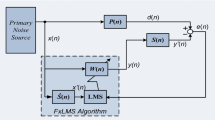Abstract
The active noise control is the best approach to limit the low-frequency noise present in any applications and also to estimate the signals, which are corrupted by interference or additive noise. In this paper, the design of an active noise control system is proposed with the hybrid combination of functional link artificial neural network and finite impulse response filter. The filter coefficients of both functional link artificial neural network and finite impulse response filters are optimized by firefly algorithm, and the ensemble mean square error value is computed through the filtered-s least mean square algorithm, in which the convergence of the filter is improved through the proposed approach. The signals like Chaotic noise signal and Gaussian noise signal are considered to assess the proposed method. Then, the noise reduction capability of the proposed active noise control with firefly algorithm is compared with that achieved by the same active noise control with another optimization algorithm known as BAT algorithm in place of firefly algorithm. The performance analysis is carried out under the MATLAB environment.












Similar content being viewed by others
Explore related subjects
Discover the latest articles, news and stories from top researchers in related subjects.References
Han Y, Xu L, Yao G, Zhou LD, Mansoor Chen C (2009) The adaptive signal processing scheme for power quality conditioning applications based on active noise control (ANC). Electro ir Elektrotechnika 96(8):9–14
Bismor D (2015) Extension of LMS stability condition over a wide set of signals. Int J Adapt Control Signal Process 29:653–670
Nakagawa CRC, Nordholm S, Yan WY (2015) Analysis of two microphone method for feedback cancellation. IEEE Signal Process Lett 22(1):35–39
Chen K, Paurobally R, Pan J, Qiu X (2015) Improving active control of fan noise with automatic spectral reshaping for reference signal. Appl Acoust 87(1):142–152
Sun G, Feng T, Li M, Lim TC (2015) Convergence analysis of FxLMS-based active noise control for repetitive impulses. Appl Acoust 89(1):178–187
Qiu Z, Lee CM, Xu ZH, Sui LN (2016) A multi-resolution filtered-x LMS algorithm based on discrete wavelet transform for active noise control. Mech Syst Signal Process 66(1):458–469
Patel V, George NV (2015) Nonlinear active noise control using spline adaptive filters. Appl Acoust 93(1):38–43
Gan Z, Hillis AJ, Darling J (2015) Adaptive control of an active seat for occupant vibration reduction. J Sound Vib 349(1):39–55
Iqbal N, Zerguine A, Al-Dhahir N (2015) Decision feedback equalization using particle swarm optimization. Signal Process 108(1):1–2
Shi C, Kajikawa Y (2015) Identification of the parametric array loudspeaker with a Volterra filter using the sparse NLMS algorithm. In: IEEE international conference on acoustics, speech and signal processing (ICASSP) Brisbane Australia, pp 3372–3376
Martinek R, Kelnar M, Vanus J, Koudelka P, Bilik P, Koziorek J, Zidek J (2015) Adaptive noise suppression in voice communication using a neuro-fuzzy inference system. In: Telecom signal processing (TSP), pp 382–386
Milani AA, Panahi IMS, Loizou PC (2009) A new delayless subband adaptive filtering algorithm for active noise control systems. IEEE Trans Audio Speech Lang Process 17(5):1038–1045
Barbieri R, Barbieri N, Lima KFD (2015) Some applications of the PSO for optimization of acoustic filters. Appl Acoust 89(1):62–70
Patel V, George NV (2015) Partial update even mirror fourier non-linear filters for active noise control. In: 23rd Euro Signal Processing Conference (EUSIPCO) Nice France, pp 295–299
Zhao H, Zeng X, He Z, Yu S, Chen B (2016) Improved functional link artificial neural network via convex combination for nonlinear active noise control. Appl Soft Comput 42(1):351–359
Kolinova M, Prochazka A, Mudrova M (1998) Adaptive FIR filter use for signal noise cancelling. In: Neural networks for signal processing VIII Cambridge UK, pp 496–505
Singh V, Veer K, Sharma R, Kumar S (2016) Comparative study of FIR and IIR filters for the removal of 50 Hz noise from EEG signal. Int J Biomed Eng Technol 22(3):250–257
Choudhary M, Narwaria RP (2012) Suppression of noise in ECG signal using low pass IIR filters. Int J Electron Comput Sci Eng 1(4):2238–2243
Hansen PC, Jensen SH (1998) FIR filter representations of reduced-rank noise reduction. IEEE Trans Signal Process 46(6):1737–1741
Bamberger RH, Smith MJ (1992) A filter bank for the directional decomposition of images: theory and design. IEEE Trans Signal Process 40(4):882–893
Sicuranza GL, Carini A (2011) A generalized FLANN filter for nonlinear active noise control. IEEE Trans Audio Speech Lang Process 19(8):2412–2417
Sicuranza GL, Carini A (2012) On the BIBO stability condition of adaptive recursive FLANN filters with application to nonlinear active noise control. IEEE Trans Audio Speech Lang Process 20(1):234–245
Zhao H, Zeng X, Zhang J (2010) Adaptive reduced feedback FLNN filter for active control of nonlinear noise processes. Signal Process 90(3):834–847
Sicuranza GL, Carini A (2011) Adaptive recursive FLANN filters for nonlinear active noise control. In: IEEE international conference on acoustics, speech, signal processing (ICASSP), Prague, Czech Republic, pp 4312–4315
Chang DC, Chu FT (2014) Feedforward active noise control with a new variable tap-length and step-size filtered-X LMS algorithm. IEEE/ACM Trans Audio Speech Lang Process 22(2):542–555
George NV, Panda G (2012) On the development of adaptive hybrid active noise control system for effective mitigation of nonlinear noise. Signal Process 92(2):509–516
Arora S, Singh S (2013) The firefly optimization algorithm: convergence analysis and parameter selection. Int J Comput Appl 69(3):48–52
Das DP, Mohapatra SR, Routray A, Basu TK (2006) Filtered-s LMS algorithm for multichannel active control of nonlinear noise processes. IEEE Trans Audio Speech Lang Process 14(5):1875–1880
Denton TA, Diamond GA (1991) Can the analytic techniques of nonlinear dynamics distinguish periodic, random and chaotic signals? Comput Biol Med 21(4):243–263
Yang X-S, Gandomi AH (2012) Bat algorithm: a novel approach for global engineering optimization. Eng Comput 29(5):464–483
Author information
Authors and Affiliations
Corresponding author
Ethics declarations
Conflict of interest
The authors declare that they have no conflict of interest.
Rights and permissions
About this article
Cite this article
Walia, R., Ghosh, S. Design of active noise control system using hybrid functional link artificial neural network and finite impulse response filters. Neural Comput & Applic 32, 2257–2266 (2020). https://doi.org/10.1007/s00521-018-3697-5
Received:
Accepted:
Published:
Issue Date:
DOI: https://doi.org/10.1007/s00521-018-3697-5




